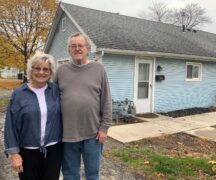By JAN LARSON McLAUGHLIN
BG Independent News
A divided Bowling Green Planning Commission has tossed the hot potato of historic preservation into City Council’s lap.
By a vote of 6 to 3 Wednesday evening, the planning commission did not make a recommendation – but instead sent the revised historic preservation ordinance to City Council for its “extensive review and revision.” Council was advised to pay attention to property owner rights and the appeals process in the ordinance.
Several members of the planning commission voiced their support of historic preservation – but not as it is proposed by the city’s Historic Preservation Commission.
There are currently 78 cities in Ohio with historic preservation ordinances – including every other university community in the state except Bowling Green.
The historic preservation commission is experiencing deja vu with this latest attempt to get an ordinance passed. Seven years ago, historic preservation was suggested in Bowling Green, but it failed due to opposition primarily from large landlords.
This time around, erroneous information was put into mailboxes of historic homes along West Wooster Street, “seeking to derail the ordinance,” said Les Barber, a member of the historic preservation commission.
“This is cowardly. This is despicable,” Barber said.
Among the sticking points with the ordinance are the number of votes landlords get when creating historic districts, and the fairness of requiring only owners of historic homes to meet standards.
The planning commission members expressed frustration because the historic preservation commission ignored some of the changes the planning commission recommended for the proposed ordinance. President Jeff Betts said the historic preservation group “disregarded” several suggestions.
“I support the core value of historic preservation in Bowling Green” – but not as proposed in the ordinance, Betts said.
Planning commission member Judy Ennis agreed.
“I firmly believe City Council needs to take a hard look at the issues that have been raised,” Ennis said.
But the historic preservation members voiced concern that any further watering down of the ordinance would render it useless. The board worked 18 months on fine-tuning the ordinance, said John Sampen, chair of the Historic Preservation Commission.
“I kind of resent” that the planning commission is now saying “forget it,” if all the recommendations weren’t incorporated in the ordinance, Sampen said.
“The HPC has already compromised on many issues,” Barber said. “Further weakening of the ordinance jeopardizes any meaningful historic districts in the city.”
Who gets to vote?
In Athens, Oxford and Perrysburg, the decision for an area to become part of a historic preservation district is made by the city and property owners don’t get a vote. In Kent, owners get one vote for each property they own in a given area.
Bowling Green’s proposed ordinance would give each property owner one vote – regardless of the number of properties they own. So if a landlord owned eight homes on a block, he would just have one vote.
Sampen explained the rationale.
“We don’t give extra votes to people who are richer than others, or own more property,” he said.
If landlords were given one vote for each rental property, “these owners would have near veto power,” and few historic preservation districts would be created, Barber said.
The proposed BG ordinance requires a simple majority of just over 50% approval to create a district. Some landlords and members of the planning commission have suggested that the burden be higher, and that support of 60% of the landowners, 66% of the landowners, or two-thirds of the front footage be required.
Weighing in on issue
The city planning department and Historic Preservation Commission have received written comments from people on both sides of the issue.
Landlord Bob Maurer suggested that inclusion in historic preservation should be voluntary. David and John Maurer wrote that property owners who face additional fees, building costs, and time for permits should be able to opt-out.
Planning Director Heather Sayler referred to five letters of support sent by homeowners on West Wooster Street, Wallace Avenue, and someone who grew up near the county courthouse.
Sampen read off the names of 14 homeowners in the historic Boomtown area who support the historic preservation ordinance.
“There is a groundswell from our perspective,” he said.
“We are convinced this would be for the eventual greater good of our city,” Barber said.
But not everyone shares that belief.
Mark Heider, who owns a historic home on West Wooster Street, said the goals of historic preservation are laudable.
“But the burden of meeting those goals should not fall upon historic home owners,” he said.
If the goal is to beautify Bowling Green, then all the homes in the city should be subject to the same rules, Heider said.
The proposed ordinance seeks to benefit the community through restrictions on private property owners, he told the planning commission Wednesday evening. The requirements are similar to those in a homeowners association – but without any input or previous knowledge before buying the homes, he said.
“We should be free to do what we want to,” Heider said of renovations to historic homes. “Let me be clear. It’s my property, not my neighbor’s property.”
For the greater good
Sampen said some changes to the proposed ordinance were made based on planning commission recommendations. He defended the revised product as a “gentle ordinance, sensitive to the needs of the city.”
Barber said the historic preservation effort could slow the cultural decline experience in the older housing stock in the last few decades.
“For 18 months we have worked diligently,” Barber said. “We’re excited about the prospect of the increased stature Bowling Green could achieve.”
But planning commission member Erica Sleek said she agreed with Bob Maurer that any involvement in historic preservation efforts should be voluntary.
“As a homeowner, I would not like the city to come in and tell me that I have to preserve my home, and how,” Sleek said.
But other planning commission members defended the historic preservation efforts that are already in place in 78 Ohio cities.
Bob McOmber, of the planning commission, said the negatives of such efforts have been exaggerated. The ordinance only sets requirements for major exterior renovations – not interior changes.
“I think the intent of the ordinance is to work with people,” he said.
However, McOmber said he has concerns about limiting landlords to one vote per historic district, even if they own multiple parcels. He suggested that the historic prevention coalition instead work hard to convince large landowners of the value of being part of a historic district.
“It would take some work to convince some of the major property owners in Bowling Green,” but the result would be worthwhile, he said.
Planning commission member Kris Phillips also voiced his support of historic prevention efforts in the city. The ordinance would prevent “somebody building a quonset hut” in front of a historic home on West Wooster Street, he said.
“I’ve been kind of disheartened” to hear so much focus placed on the perceived negatives about historic preservation, Phillips said. “I see it was a positive all around.”
The goal is not to penalize or prevent a homeowner from doing what they want with their property – but to help them maintain the integrity of the home, Phillips said. The result would be increased property values, and a potential to attract more residents to Bowling Green.
“This perception that we’re going to be walking around with our rulers to penalize people,” is just not true, he said. “It’s sad for me to hear that.”
Why adopt an ordinance?
The goal of the historic preservation plan is to help the city retain historically significant structures.
The first step is getting Certified Local Government status for the city. That would allow the community to create a plan, and make it possible for homeowners and businesses to get grants and tax credits to protect historic buildings.
The commission’s goal is to “preserve, promote, encourage and support the maintenance, use and reuse of historic buildings in the city.” It is designed to help property owners who want to preserve historic structures.
Some historic homes are losing the battle against time and rental transformation. And the longer the preservation efforts are on hold, the more some structures deteriorate, commission members have said.
The objective of historic preservation is to protect the historic integrity of buildings – and help when possible with restorations. It is not to nitpick and tell homeowners what they can and cannot do with their properties, commission members have stressed.
The plan would require property owners in designated historic areas to meet standards when making substantive changes to the exterior of buildings. There would be no rules for the interior of structures.





